Just before the excitement of setting up my show at the Spring Knitting and Stitching Show, I made time to go and see the breathtakingly spectacular show ‘For worship and glory: A unique exhibition of Ecclesiastical Embroidery’ at Ely Cathedral, curated by the Royal School of Needlework.
In case you hadn’t realised by now, Goldwork is fast becoming ‘my thing’, especially when worked to exemplary standards – and here was exquisitely worked embroidery showcasing, in my opinion, the very best of the discipline. To say I was excited about seeing the show was an understatement: I haven’t been this excited since my favourite band last toured the UK. Granted, this was a show that didn’t require sleeping on the pavement the night before, but on the rainiest and greyest of winter days the wonders the Cathedral held truly were the illumination of the day.
As if the embroidery exhibition were insufficient to leave me speechless, the cathedral itself is a place of breathtaking beauty. I can confidently say that cathedral architecture is my favourite man-made structure, and regardless of one’s faith (or indeed lack of it), cathedral architecture can inspire and be enjoyed by all. My inner goth marvels at the gothic tracery, intricately-cut stones, vaulted ceilings and exquisite craftsmanship. In addition to all this gothic glory, Ely hosts a unique window set into the ceiling of the main knave, an octagonal ‘lantern’ allowing even more light into the building. It truly was a wonderful place to stand directly underneath, in the quietness and stillness of the cathedral, and feel pleasantly overwhelmed and insignificant against the glory of God’s architecture.
However, before I spent my entire time there prancing around vaulted stone corridors in black lace skirts, there was the exhibition itself in the Lady Chapel. The show comprised of various items of ecclesiastical work, including samplers from Royal School of Needlework apprentices, altar frontals and a stunning Medieval cope. To see these items in picture format simply is not enough: it is only when presented with the ‘real thing’ can one truly study and thus appreciate the craftsmanship and the detail involved in their construction. (Unfortunately photography was forbidden and all subsequent images here are taken from postcards.) 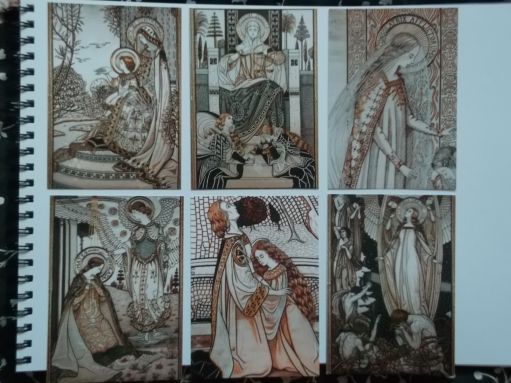
The highlight of the show, however, had to be the ‘Litany of Loreto’ series of panels: a collection of embroideries believed to have been worked by nuns sometime in the 20th century. Of the 12 in existence, 6 were on show here. Having seen glimpses of them in the RSN’s studio before, to see them in their ‘intended setting’ – surrounded by the open space and vaulted ceiling of the church – lent them yet another level of inspiration.They are absolutely exquisite examples of ecclesiastical subject matter, worked in gold and silk yet with their own unique style – muted colours, subtle shading and a delicacy of detail.
Their muted colour palette is unusual in the world of ecclesiastical embroidery: instead of showcasing vibrantly coloured silks and velvet adorned with copious amounts of gold thread, here a far more subtle approach has been taken. Muted browns, greys and creams sit alongside a sparing and thoughtful use of gold highlights. What appear to be black areas are, I believe, actually very dark grey – maintaining depth of tone without the ‘dullness’ pure black might bring.
For me, the true depth of the detail lies in the execution of the hair. Worked in single-stranded silk shading, with colours carefully placed to accentuate highlights and shadows in bouncing curls and flowing tresses, it truly is exceptional workmanship. Juxtaposed with the density of the hair’s stitching is the lightest of shadows used to define the face and chin, with very pale grey long ‘crosshatching’ stitches suggesting an outline without disrupting the delicacy of the overall effect.
Even a veil is suggested with the lightest of rows of split stitch worked on top of the hair, the direction of the pale silk lines sweeping downwards to suggest fabric falling. A double row of couched gold (Jap? Passing?) contrasts around the inside of the halo, a solid line amongst so many fluid ‘folds’ of fabric.
Stylistically, the pieces remind me of the soft curves yet defined lines of Art Nouveau. At the same time there seems a Pre-Raphaelite quality to the long flowing hair and the sensuality inherent there. It’s a shame that little is known of their origin or designer, except that the pieces originally belonged to the Convent of the Holy Child in Maybury, East Sussex until they were bequeathed to the Royal School of Needlework.
I’m not easily overwhelmed but this series has truly inspired me to get my goldwork going again….
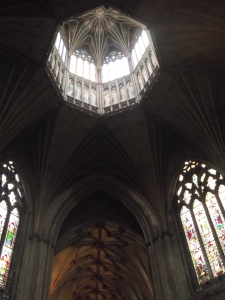

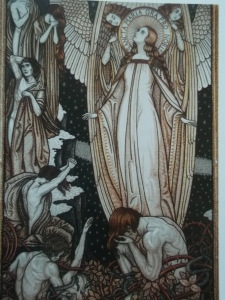
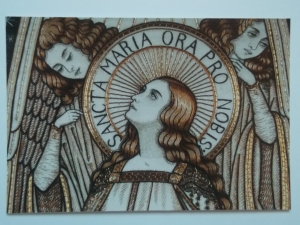
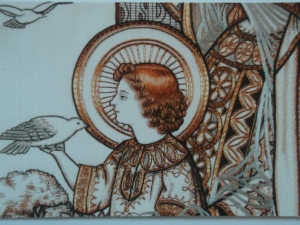
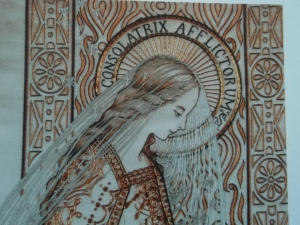



[…] of my readers will remember this post in which I described my moving and highly influential visit to Ely Cathedral’s ecclesiastical […]